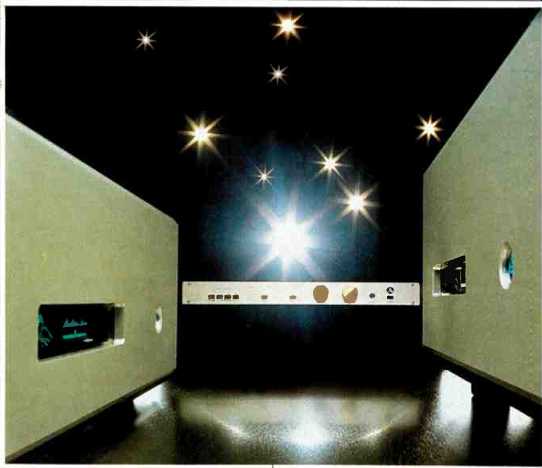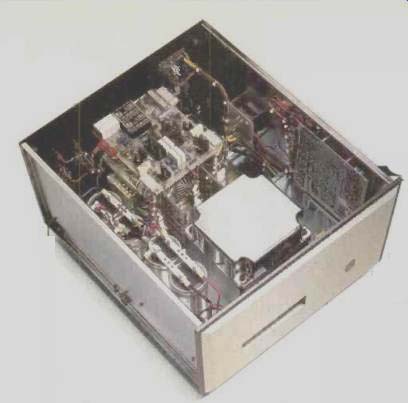LIKE A SWISS WATCH

As I write this, the Iraqi crisis is worsening, the stock market is plunging, and the world seems to be going to hell in a handbag. So I feel a bit guilty writing about something as comparatively trivial as an extraordinary new preamplifier and power amp, even though they are surely the most glittering technological stars in the firmament of high-end audio.
The village of Wadenswil, near Zurich in Switzerland, is the home of the small plant of FM Acoustics Ltd. From this modest facility comes the most beautiful, precision-crafted, sophisticated and best-sounding preamplifier and power amplifier I have ever heard.
FM Acoustics is owned by Manuel Huber, a brilliant and innovative audio and design engineer whose technical expertise is augmented by his deep and abiding love of music. For 17 years, Huber has been making high precision preamplifiers, power amplifiers, and electronic crossovers for the professional audio industry. Famous as much for their reliability as for their performance, FM Acoustics electronics are in use in recording and broadcast facilities throughout the world.
For the past seven years, Huber has been involved in research and development of a totally uncompromised, cost-no-object preamplifier and power amplifier for the high-end audiophile market, his personal "Holy Grail." Huber has now introduced his Resolution Series 611 and 811 amplifiers and 244 preamplifier. These products embody many of his innovative ideas in fabrication (including the use of custom-built, proprietary components) and include many unusual electronic features that contribute to performance, reliability, and protection of the equipment.
I briefly used the 611 amplifier but for some months now have been using the 811 power amplifier and the 244 preamplifier. Most of my comments on the 811 apply equally to the 611.
Huber's design philosophy is interesting. He quite rightly points out that amplifier design is a fairly mature technology. Huber feels there is much to be gained by the refinement and proper execution of many aspects of current amplifier designs. Many of these refinements are expensive, either in the basic costs of superior-quality components or in labor-intensive fabrication and testing procedures and techniques. In the pursuit of these refinements and the inclusion of his own ideas into his 244 preamplifier and 811 power amplifier, Huber has slain many sacred cows and stripped away some of the mythology that has encumbered amplifier design and fabrication for many years.
The FM Acoustics 244 preamplifier measures 17 1/2 in. wide, 10 1/2 in. deep, and 1 3/4 in. in height. Its 4-mm-thick aluminum enclosure is laser-cut and laser-polished to a unique satin finish. The front and back panel lettering is negatively anodized so it can never wear off.
The FM Acoustics 811 Resolution Series power amplifier measures 17 1/2 in. wide, 21 in. deep, and 9 in. in height, and weighs 115 pounds. Its panels are also laser-polished to match the preamplifier. The front panel has an illuminated power switch and a central display that can indicate fault conditions.
Some expensive high-end amplifiers have separate left and right power supplies. Many even use monoblock construction, making the left and right channels separate amplifiers. The FMA 811, however, is configured as a stereo amplifier on a single chassis. Cost-cutting is not a consideration in the 811, and there are surprising and sound technical reasons, which I will detail next month, why FM Acoustics chose this kind of construction.
To fully describe and convey a true appreciation of the engineering masterpiece that is the FM Acoustics 811 power amplifier would require a great many pages in this journal; if ever a product epitomized the term "built like a Swiss watch," it is this fabulous amplifier. One would have to describe the meticulous and unrelenting attention to every detail of the unit. One would have to cite the use of the finest components and materials, and the ultra precision fabrication. Above all, one would have to understand the importance of the exhaustive testing (much of it using proprietary procedures) of virtually every component in the FMA 811 amplifier.

---- The FM Acoustics Resolution Series Model 811 amplifier.

----- The Model 244 preamplifier.
A good example of the rigorous testing procedures is the special selection of all transistors used in both the 811 amplifier and 244 preamplifier. The 24 bipolar power transistors used in the 811 are proprietary designs made only for FM Acoustics. The 250-V, 9\4 30-A chip is hermetically sealed in a ceramic case. Chip size defines the amount of current the transistor can supply. The average chip on a standard power transistor is around 10 square millimeters, while the FM Acoustics chip is 46 square millimeters. Thus the FM Acoustics chip is about five times larger than a normal transistor, and is also super high speed, about 10 times faster than standard transistors.
All FM Acoustics transistors are tested on a specially modified $40,000 curve tracer. A certain voltage is set, a certain bias resistance is set, and then the current is turned up and down very slowly, carefully observing the transfer curves for any anomalies. When a transistor is found that fulfills all the desired requirements, the tracer is switched over to the "B" test side. Other transistors are then tested to try and find one that absolutely matches the first transistor in all parameters, both statically and dynamically. This is all done by hand and is very tedious, time-consuming, and expensive. In the construction of a 244 preamplifier and an 811 power amplifier, as many as several hundred transistors must be tested to come up with the requisite number of matching transistors with identical transfer curves. These matched transistors are used in the positive and negative sides of the amplifier. This ensures that no distortion will be generated--it is actually cancelled within the stage, thus obviating the need for error correction or feedback.
In the 811, all stages are discrete Class A. There is a balanced input stage with a common-mode rejection of 90 db. Then come three voltage gain stages, in finely tuned steps. Next is a precision predriver stage, the driver stage, and lastly the output stage.
All these discrete Class-A stages are cascaded in the 811. Each stage affords optimal performance, and there is no excessive demand on an individual stage. Thus there is always plenty of reserve in each stage; this also improves long-term stability.
With all stages running in Class A, using rail voltages of ±95 V and quite a bit of bias current, forced-air cooling (via an ultra-quiet fan) is required. This not only provides long-term reliability but also keeps the power transistors in the best temperature range for optimum performance. The fan has two speeds, but in my experience it only goes into its higher speed when very high-level, bass-heavy and long sustained passages of music occur. As a further aid in maintaining optimal temperature range on the power transistors, they are mounted directly on the cooling fins without insulating washers.
It should be noted that the use of matched transistors-all pure Class-A operation, no feedback-and all other features of the 811 amplifier apply equally to the 244 preamp.
In many ways, Huber takes a different approach to various aspects of amplifier design as compared to those of most high-end amplifiers. The typical high-end amplifier uses a toroidal transformer in its power supply. For the 811, Huber fabricates his own leaf type transformer with a capacity of 2,900 VA continuous, and 9 kVA on peak repetitive impulses. Toroidal transformers certainly are preferred to the usual commercial leaf-type transformers which are notorious for their hum, stray fields, and mechanical noises from the stacked leaf plates.
But the 811's transformer is another matter altogether. The leaf plates are made of a special high-performance steel (currently supplied only to the Swiss military and FM Acoustics) with a unique, proprietary version of grain-orientation, resulting in extremely low losses and hum, and stray fields that are an order of magnitude lower than those from toroidal transformers.
Huber points out that a toroidal transformer of similar capacity to the 811 leaf-type would be inordinately large, very heavy, and difficult to mount safely. Because of manufacturing tolerances inevitable in toroidal transformers where the metal core joins, there is very strong and directional magnetic radiation. Huber must pay dearly for his special transformers because they must be handmade. Each metal leaf plate is individually welded, so that the resultant stack has immense rigidity and produces no mechanical hum.
Proprietary winding techniques are used to complete the transformer, and then a proprietary insulating material is used that can handle 4,000 volts! This careful hand-crafting is obviously quite expensive.
The FM Acoustics 811 power amplifier and 244 preamplifier are the most sophisticated audio amplification equipment that I have ever encountered, and the build quality is breathtaking in its fastidious and meticulous craftsmanship.
There is much cutting-edge technology in these units in respect to such things as special power-supply circuitry and capacitors, the enormous output-current capabilities, an on-board computer that monitors (at 20 times per second) such things as d.c. offsets, high-frequency oscillation, continuous and peak output currents, rail voltage, output voltage, temperature, and bias. There are also new ideas on amplifier/speaker interfaces and myriad other things, to say nothing of the incredible sonic performance of these units. All of these features and capabilities deserve full documentation, which I will provide in my next column.
(adapted from Audio magazine, Nov. 1990; Bert Whyte)
= = = =